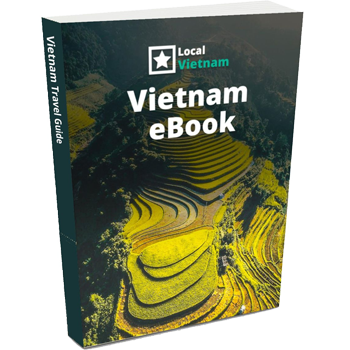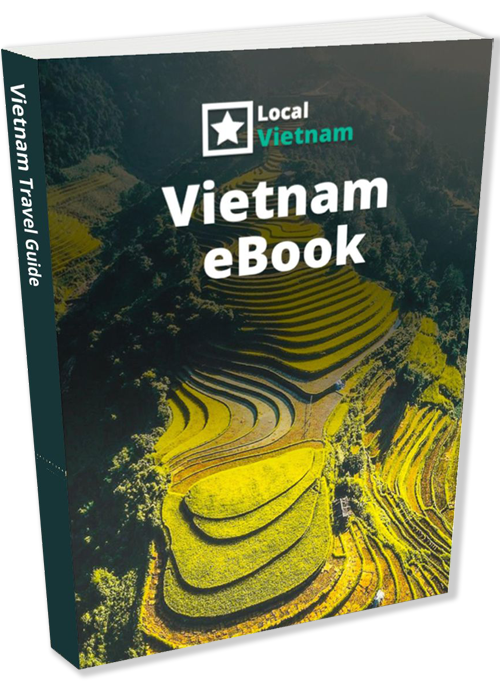Can you use ChatGPT in Vietnam?
Yes — ChatGPT works perfectly fine in Vietnam, unlike in some countries where it’s restricted. You can use it through the official mobile app or directly on the OpenAI website, as long as you have an internet connection.
To stay connected during your trip, it’s best to get a Vietnamese SIM card or eSIM with mobile data. This way, you can use ChatGPT on the go — whether you’re in the city or a remote mountain village.
Need help getting connected? Check out our article: How to get a Vietnamese SIM card
How ChatGPT can help before you travel
Whether you’re building an itinerary or just figuring out where to go, ChatGPT can save you hours of searching. Here’s how to use it effectively during the planning phase of your Vietnam trip — plus what to watch out for.
1. Build a custom itinerary
You can ask ChatGPT to help create a travel plan based on your interests and number of days.
Prompt idea:
“Can you help me plan a 10-day Vietnam itinerary with a mix of culture, beaches, and food?”
It’s great for giving you a first draft — which you can then fine-tune. You can also ask to adjust the plan for the weather, travel speed, or flight arrivals.
Note:
It’s not pulling data from live sources like bus schedules or entrance times — double-check transport and opening hours with official sources or booking sites.
2. Compare Destinations
Not sure whether to go to Phong Nha or Ninh Binh? Ask ChatGPT to compare them based on your travel style.
Prompt idea:
“What’s the difference between Ha Giang and Sapa for a 3-day trekking trip in October?”
You’ll get quick comparisons based on landscape, tourist crowds, difficulty level, and accessibility.
Note:
It can occasionally overgeneralize — if something sounds off, ask a follow-up question or cross-check.
3. Understand visa requirements
Ask ChatGPT about Vietnam visa rules based on your nationality.
Prompt idea:
“Do Dutch citizens need a visa to enter Vietnam in 2025?”
“Can I apply for a Vietnam e-visa on arrival?”
Important:
Visa policies change frequently. Always double-check with an official government site or airline after using ChatGPT to get an overview.
4. Check weather by bonth
You can get a general idea of what the weather will be like for each region in each month.
Prompt idea:
“What’s the weather like in Hue in September?”
“When is the best time to visit Phu Quoc?”
ChatGPT can help you understand rainy vs. dry seasons, temperature ranges, and whether a destination is worth visiting in a specific month.
Note:
ChatGPT can’t give forecasts — it only provides typical seasonal trends.
5. Translate travel content
You might find great travel tips on Vietnamese blogs, local forums, or booking sites with no English version.
Prompt idea:
“Can you translate this Vietnamese text into natural English?” (Then paste the text.)
Or use it to summarize long content and pull out just the parts you care about (like prices, activities, or local advice).
6. Ask instead of Googling
Travel forums can be time-consuming and confusing. With ChatGPT, you can just ask a direct question like:
“Is Ninh Binh worth visiting in the rainy season?”
“How long should I stay in Da Lat?”
“How do I travel from Hanoi to Cao Bang?”
It’s faster than scrolling through ads, outdated blogs, or endless Reddit threads.
Note:
ChatGPT is not connected to live travel sites unless you’re using ChatGPT Plus with browsing (and even then, use caution with real-time details).
Using ChatGPT while you travel in Vietnam
Once you’re in Vietnam, ChatGPT becomes like a travel assistant in your pocket. From adjusting plans to understanding cultural details, it can help you stay flexible, make quick decisions, and navigate unfamiliar places more smoothly.
Here’s how to get the most out of it on the road:
1. Get local food suggestions
Ask for food recommendations by city, region, or type of dish. You can also ask for safe street food options, or suggestions for vegetarians or specific allergies.
Prompt idea:
“Where can I try good vegetarian food in Hue?”
“What street food should I try in Hanoi, and what’s in each dish?”
Tip:
ChatGPT won’t know which restaurants are currently open or trending — it’s best used for understanding what to eat, not booking tables.
2. Create or adjust day plans on the go
If your plans change or you arrive in a city with no idea what to do, ChatGPT can help you create customized day plans.
Prompt idea:
“I’m in Hoi An for one day — what should I do if I want to avoid crowds?”
“Can you suggest a slow-paced itinerary in Hue with historical sights and cafes?”
You can also ask it to revise your plan based on weather, energy level, or transport changes.
3. Ask for cultural or local etiquette advice
Not sure what to wear at a temple, or how to act in a local homestay? ChatGPT can give quick etiquette tips.
Prompt idea:
“What should I wear when visiting a pagoda in Vietnam?”
“What’s the polite way to decline food in a Vietnamese home?”
4. Get help navigating language
Need help understanding signs, labels, or basic conversations? You can ask ChatGPT to translate short sentences, explain Vietnamese phrases, or help you say something to a local.
Prompt idea:
“How do I say ‘no sugar’ in Vietnamese?”
“This menu item says ‘cháo lòng’ — what is it?”
If you’re using the mobile app, you can also type a message and show it to someone locally — or ask ChatGPT to translate it back and forth in real time.
5. Make decisions faster
On the go and unsure whether to skip a sight or take the long scenic route? ChatGPT can help you weigh the pros and cons.
Prompt idea:
“Should I visit Ba Be Lake if I only have one extra day after Cao Bang?”
“What’s better for rainy weather in Hanoi — a museum or a cooking class?”
It won’t decide for you, but it gives enough insight to help you make informed, faster decisions.
6. Quick help with local transport
ChatGPT can explain how to get from one place to another — even in rural areas where transport options are limited.
Prompt idea:
“How do I travel from Ninh Binh to Phong Nha?”
“Is there a direct bus from Ha Giang to Cao Bang?”
Important:
ChatGPT does not pull live schedules. Use it for understanding your options, then confirm with booking apps (like 12Go, Baolau, or local agencies).
Tips for using ChatGPT as a language tool
While Google Translate is handy, ChatGPT gives you more flexibility when it comes to understanding real-world language situations — especially in a country like Vietnam, where English is not widely spoken outside major cities and tourist areas.
Here’s how to use ChatGPT effectively for translation, pronunciation, and communication help — including a few photo-based tips you might not know.
1. Pre-write messages for easy communication
One of the most useful ways to use ChatGPT in Vietnam is to prepare short, clear messages you can show to locals — especially when you know language might be a barrier.
You can ask ChatGPT to help write messages in Vietnamese for all kinds of common situations, such as:
- Taxi drivers: “Can you take me to this hotel?” or “Please stop here.”
- Restaurants: “I can’t eat peanuts” or “No chili, please.”
- Homestays or hotels: “What time is breakfast?” or “Do you have hot water?”
- Tour guides: “I’ll need to take regular breaks” or “Can we skip the cave part?”
Prompt idea:
“Can you translate this into Vietnamese: ‘I’m allergic to seafood, please make sure there’s no shrimp or fish sauce’ — and include pronunciation?”
This makes interactions less stressful, avoids misunderstandings, and shows locals that you’ve made an effort — which is always appreciated.
2. Translate menus, signs, or labels using the photo tool
If you’re using the ChatGPT app (on iOS or Android) and have a paid Plus subscription, you can upload photos of menus, signs, food packaging, or handwritten notes.
Example use:
- Take a photo of a restaurant menu → ask:
“Can you translate this menu into English and explain what each dish is?”
This works much better than Google Translate for understanding what you’re actually about to eat — especially when it comes to local dishes like bún chả or nem nướng that may not have a direct translation.
3. Understand Vietnamese phrases or slang
Locals may use words or expressions that don’t translate well with standard tools.
Prompt idea:
“Someone just said ‘đi chơi’ — what does that mean in this context?”
“What’s the difference between ‘ăn’ and ‘dùng’ when talking about food?”
You can also paste messages from booking apps, homestay hosts, or drivers and ask for a clearer English version.
4. Using voice mode for quick translations
If you’re using the ChatGPT app, you can speak instead of typing — or even have a short voice conversation with ChatGPT. This is especially useful when you’re on the move and want to quickly translate or ask how to say something in Vietnamese.
However, ChatGPT is not a live translator like Google Translate’s conversation mode. You can’t hold it between two people and have it auto-translate back and forth in real time.
That said, because it’s powered by AI, ChatGPT often gives clearer, more natural translations — especially for polite phrasing, full sentences, or when you’re not sure if something sounds right.
Best use: Speak your question → get a polite, accurate translation → show or play it to the person you’re talking to.
5. Say something in Vietnamese (with pronunciation help)
Need to say something polite or important? ChatGPT can help translate and also explain how to pronounce it.
Prompt idea:
“How do I say: ‘I don’t eat meat’ in Vietnamese? Please include pronunciation.”
ChatGPT will typically reply with something like:
“Tôi không ăn thịt” (pronounced: toy khong an tit)
You can also ask for simplified versions if needed.
6. Fix or clarify Google Translate errors
Google Translate sometimes creates awkward or robotic translations. You can paste them into ChatGPT and ask for a more natural-sounding version.
Prompt idea:
“I tried to say this using Google Translate — does it sound okay? Can you improve it?”
This is especially useful if you want to leave a message for a local host or guide, and want to make sure it’s polite and clear.
7. Build a mini phrasebook
You can ask ChatGPT to create short, personalized lists of useful phrases for specific situations — taxis, restaurants, homestays, or hospitals.
Prompt idea:
“Can you give me 5 useful Vietnamese phrases for ordering food, with English and pronunciation?”
This is a great way to learn just enough to get by, without having to download a separate app or phrasebook.
Limitations to be aware of
ChatGPT is incredibly helpful while traveling — but it’s not perfect. Here are a few things to keep in mind:
- It doesn’t work offline. You’ll need Wi-Fi or mobile data.
- It doesn’t know real-time info. It can’t check current weather, bus times, or restaurant opening hours.
- It sometimes gets things wrong. Always double-check important details like visa rules or health info.
- It’s not a live translator. You’ll need to ask and show one side at a time — it’s not instant back-and-forth.
- It’s not a replacement for local knowledge. Great guides, local hosts, and real-life experiences still matter.
Use ChatGPT as a smart helper — not your only source.
Travel tip: Combine ChatGPT with other travel apps
ChatGPT is a powerful tool, but it works best when used alongside other apps during your trip. It’s great for answering questions, explaining things, and making suggestions — but it doesn’t replace apps that offer live data, bookings, or real-time navigation.
Here’s how to combine it for maximum travel value:
- ChatGPT + Google Maps:
Ask ChatGPT what to do in a city or region, then find exact locations, routes, or opening hours in Google Maps. - ChatGPT + 12Go / Baolau:
Use ChatGPT to understand your transport options (bus vs. train, comfort levels, timing advice), then book your ticket through 12Go or Baolau. - ChatGPT + Grab:
Let ChatGPT help you explain directions or addresses in Vietnamese, then paste those into Grab to make sure you arrive at the right place. - ChatGPT + Booking.com / Agoda:
Use ChatGPT to find out what areas to stay in, what type of place fits your needs, or how to contact a property in Vietnamese if needed. - ChatGPT + Google Translate:
If you need fast, live translation for two-way conversations, Google Translate’s voice mode works better. But if the translation sounds odd or unnatural, ask ChatGPT to clean it up.
By combining the strengths of these tools, you can make smarter decisions, avoid confusion, and travel more smoothly throughout Vietnam. Read our guide: best Apps to use while traveling in Vietnam.


